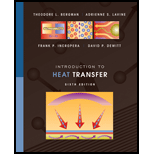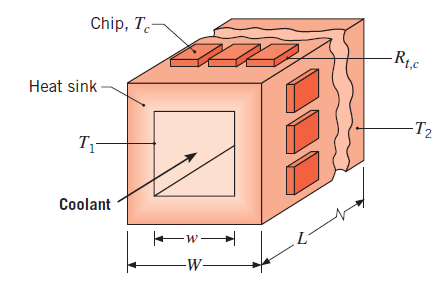
An aluminum heat sink

If
Want to see the full answer?
Check out a sample textbook solution
Chapter 4 Solutions
Introduction to Heat Transfer
Additional Engineering Textbook Solutions
Degarmo's Materials And Processes In Manufacturing
Engineering Mechanics: Statics & Dynamics (14th Edition)
Engineering Mechanics: Statics
Mechanics of Materials (10th Edition)
Applied Fluid Mechanics (7th Edition)
Engineering Mechanics: Statics
- A getter screen consists of a cylinder of length l = 0.3m, diameter d=0.25m and its circular based plate. The getter screen is cooled with liquid nitrogen and coated completely with deposited titanium providing a constantly fresh surface. Sticking probability s=1 for N2 and mean thermal velocity = 470m/s. Find the pumping speed.arrow_forward48. Water is flowing in a smooth pipe of diameter D. A section of this pipe hav- ing a length of L is heated. Water at the inlet to the heated section has a tempera- ture of Tŋ. Water temperature at the exit of the heated section is Tp. The heated section of the pipe wall is maintained at a constant heat flux so that a constant temperature difference of AT, = T, – T, exists between the wall and the bulk wa- ter temperature. Show that for turbulent flow in the pipe and a specified heated length and pipe diameter, water temperature at the exit of the heated section is given by: 402 0.6 Pr T52 =Tf +0.0876 L AT DO.8 0.2 marrow_forwardTo cool hot oil, an engineer has suggested that the oil be pumped through a pipe submerged in a nearby lake. The pipe (external diameter = 15 cm) will be placed in the horizontal direction. The temperature of the outer surface of the pipe averages 125 ° C. The surrounding water temperature is assumed to be constant at 15 ° C. Pipe length 125 m. If it is assumed that there is no water movement. a. Determine the convective heat transfer coefficient of the outer pipe surface to the water. = Answer Watt / (m² ° C) b. Determine the heat transfer rate from the pipe to the water. = Answer kWarrow_forward
- To cool hot oil, an engineer has suggested that the oil be pumped through a pipe submerged in a nearby lake. The pipe (external diameter = 15 cm) will be placed in the horizontal direction. The temperature of the outer surface of the pipe averages 125 ° C. The surrounding water temperature is assumed to be constant at 15 ° C. Pipe length 100 m. If it is assumed that there is no water movement. a. Determine the convective heat transfer coefficient of the outer pipe surface to the water. = ..... Watt / (m² ° C) b. Determine the heat transfer rate from the pipe to the water. = ..... kWarrow_forward(heat transfer ) thanks The velocity of the fluid flowing in parallel over a 500mmx500mm flat heater surface is U= 19 m/s and the inlet velocity temperature is T_∞15 C. The surface temperature of this plate is T_s140 C, the friction force is F_D=0.4 N and the surface area of the plate is A=0.32 m2. According to this;(F_D= 0.4N A=32 m2)a) Surface shear stressb) Find the coefficient of frictionc) Heat transfer coefficientd) What is the amount of heat transfer (electric power) that must be given to maintain a constant surface temperature?arrow_forwardWater going into a pipe with a tempeture of T1 and going out T2 . ambient tempeture is T0. flow rate q. Develop an expression for T2 ( based on heat transfer) Length of the pipe Lh0 - convective heat transfer coefficient of the airhW -convective heat transfer coefficient of the waterk- pipe thermal conductivity (W/m·K)d – pipe diameter Use any other varilable that you need and can be found online easily .arrow_forward
- Water (cp = 4197 J / kgC, k = 0.67W / mC, Pr = 2.2, dynamic viscosity = 352 * 10 ^ -6 Ns / m ^ 2) with a flow rate of 0.01 kg / s and an inner diameter of 0.1 m at 20C temperature It is requested to be heated to 80C. If the pipe inner wall is kept constant at 120C, what is the average logarithmic temperature difference with fully developed flow acceptance? a. 65.48 C b. 43.3 C. c. 316.3 K D. 723.4 K e. 2300 K.arrow_forwardSipho’s mother is making a fire in the stove inside a shack using coal. A fan is used to extract the flue gasfrom the fire via a chimney made of zinc material. The wall thickness of Chimney is L=4mm and the walltemperature of the chimney on the flue gas side is T_si=60˚C. Sipho, playing outside next to the chimneyexperiences an ambient temperature of 20˚C. The surrounding temperature is T_sur=35˚C and the emissivityis ε=0.95. Assume the convection coefficient is 20W/m2K and the chimney is grey material.Under these conditions determine the outer surface (air side) temperature T_so=? of the chimney.arrow_forwardCalculate the critical and actual heat flux for pool boiling of water at 2.1 bar from a surface at 130 °C. Take: Saturation temperature =123 °C PL= 941.6 kg/m', pv=1.18 Ca= 4.25 KJ/kg.°C K=687*10 W/m°C HL=230*10“ Ns/m2 2=2198 KJ/Kg 0=55*10 N/m Pw at 125°C = 2.5*10$ N/m² P,=2.25*10 N/m²arrow_forward
- Heat transfer Air flows through a smooth thin-walled rectangular duct of height, a= 0.3 m and width, b=1 m. The air is heated by the duct walls at a uniform heat flux of 250 W/m2 . At some location inside the duct, the mean velocity and temperature of air was measured to be um = 0.05 m/s and Tm = 350 K, respectively. (a) What is the hydraulic diameter of the duct? (b) What is the Reynolds number for the flow in the duct? (c) Is the flow laminar or turbulent? (d) Assuming fully developed flow, what is the heat transfer coefficient (h) at this location?arrow_forward5.0 Air at p=p= 1 atm enters a thin-walled (D=D= 5-mm diameter) long tube (L=L= 2 m) at an inlet temperature of Tm,i=Tm,i= 100°C. A constant heat flux is applied to the air from the tube surface. The air mass flow rate is m˙ =m˙ = 125 × 10-6 kg/s. If the tube surface temperature at the exit is Ts,o=Ts,o= 160°C, determine the heat rate entering the tube, in W. Evaluate properties at T=T=400 K.arrow_forwardQ) A refrigerant at |-40^ C flows into a copper pipe (400 W/mK) of 10 mm ID and 14 mm OD. A 40 mm thick shell of thermocole (0.03 W/mK) is put on the pipe to reduce losses. Estimate the heat leakage to the refrigerant per meter length of pipe, if the ambient temperature is 40°C. Assume the external and internal heat transfer coefficients are 5 W/m?K and OW / (m ^ 2) * K respectively. Calculate the amount of refrigerant evaporated per hour taking its latent heat at - 40 degrees *C as 1390 kJ/kg.arrow_forward
 Principles of Heat Transfer (Activate Learning wi...Mechanical EngineeringISBN:9781305387102Author:Kreith, Frank; Manglik, Raj M.Publisher:Cengage Learning
Principles of Heat Transfer (Activate Learning wi...Mechanical EngineeringISBN:9781305387102Author:Kreith, Frank; Manglik, Raj M.Publisher:Cengage Learning
